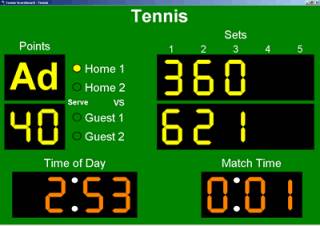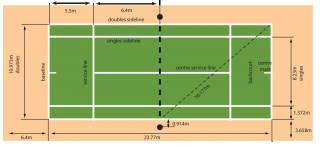Overview
Tennis was first created by the British, and has been played in England in its current form since 1873. The goal of the game is to make the ball hit your opponent's side of the court, and it difficult for him or her to hit that ball back before it hits the ground twice.
Rules of the Game
 A scoreboard for tennis
A scoreboard for tennis Every time a player manages to make the ball bounce on the opponent's side of the court without him being able to return the ball, that player gains "a point", though the way the score is actually counted seems rather arbitrary. In order to win a game, a player must score at least four points. The first three of those are then put onto the scoreboard in increments of 15, 30, 40. The fourth point would win them the game, but if the other player has also scored three points, tying the score at 40 - 40--known as a deuce--the fourth point will only lead to an advantage. The player with an advantage must then score the next point, because if he doesn't, his advantage will be nullified and the game will be back to a deuce.
Once a competitor does manage to score the points, he'll have won a single game. Games, contrary to points, are counted in simply increments of 1, 2, 3,... In order to win a set, a player must win at least six games. If, however, both players end up at 6 games, a tiebreak is used to resolve the issue. In a tiebreak, a player must get to seven points--unless, like usual the difference between both scores is less than two points--which are incremented in a 1, 2, 3,... fashion. The first player to do so wins gets a seventh game assigned to his name and wins the set. If the match is in its final set though, there is no tiebreak. In that case, the match simply goes on until one of the players gets two games over the other. In official women's matches, the final set would be the third, since women only have to win two sets in order to take home the match. They have to win five sets, and therefore, their final set would be the fifth.
Because of these rules, that force a player to win with a difference of at least two points on each of the scoring levels, tennis can potentially go on forever. The current record for the longest tennis match ever in an official ATP tournament stands at 6 hours and 33 minutes. That's how long it took Fabrice Santoro to beat Arnaud Clément at the 2004 French Open (Also known as Roland Garros).
As for actually playing the game, there are quite a few sets of rules as well. First off, the service. At the start of each match, a coin is tossed to decide who may serve in the first game of the match. From that point onward, the service changes hands each game. Winning your opponent's service game is called Breaking. Especially at Wimbledon, winning the games in which you serve is pretty much required to win the match. Wimbledon takes place on a grass court, which is a very fast surface. As such, serving allows you to take control of the rally right from the get-go. At the other Grandslam Tournaments--the Australian Open, US Open and French Open--service isn't as important, because their surfaces, like clay, are much slower than grass.

Players are confined in the way they may serve as well. The ball must always land in a certain zone of the opponent's side of the court, indicated on the picture. If they are serving on the left side of the court, they must serve the ball into the right box that's defined by the two service lines and vice versa. If they overshoot the target or hit the net the first time (although, if the ball hits the net, but still manages to tip over it and hit the zone, the serve is simply replayed), they get a second serve. If they fail the second serve as well, the opponent gets a free point. That is known as a Double Fault.
Other than that, pretty much anything is allowed. As long as you use solely your racket to hit the ball, it doesn't matter how you do it. If a ball has hit the line ever so slightly, it isn't out. The Grandslam Tournaments, barring the French Open, have installed modern technology known as "Hawk-Eye" that allows them to digitally recreate the arc and imprint of the ball on the ground very faithfully. Only the biggest stadia, like Centercourt at Wimbledon, have access to this technology though. Roger Federer, the current number 1 in the world according to the men's ATP ranking system has always expressed a strong dislike for Hawk-Eye, saying that the imprints of the ball are inaccurate.
Log in to comment